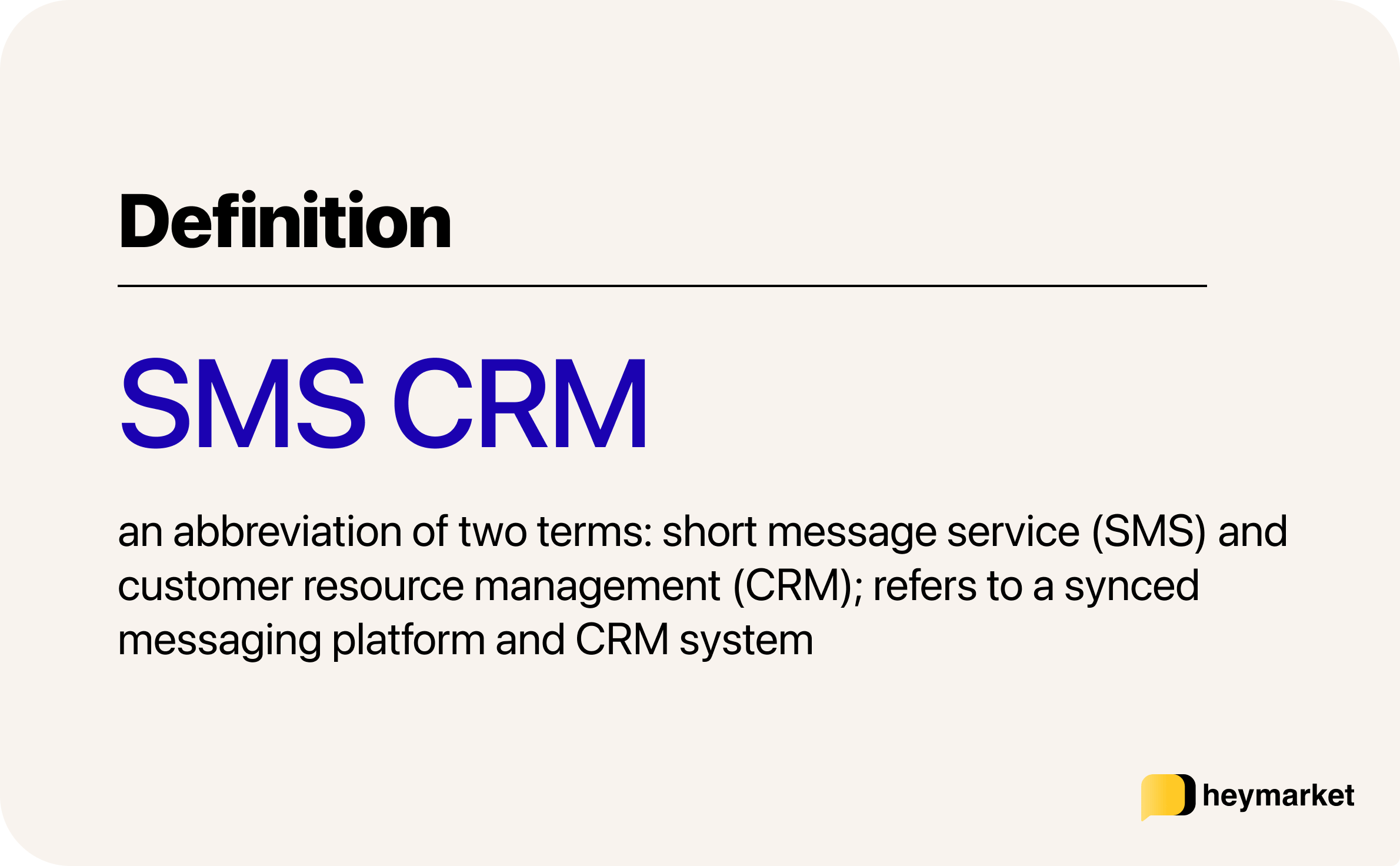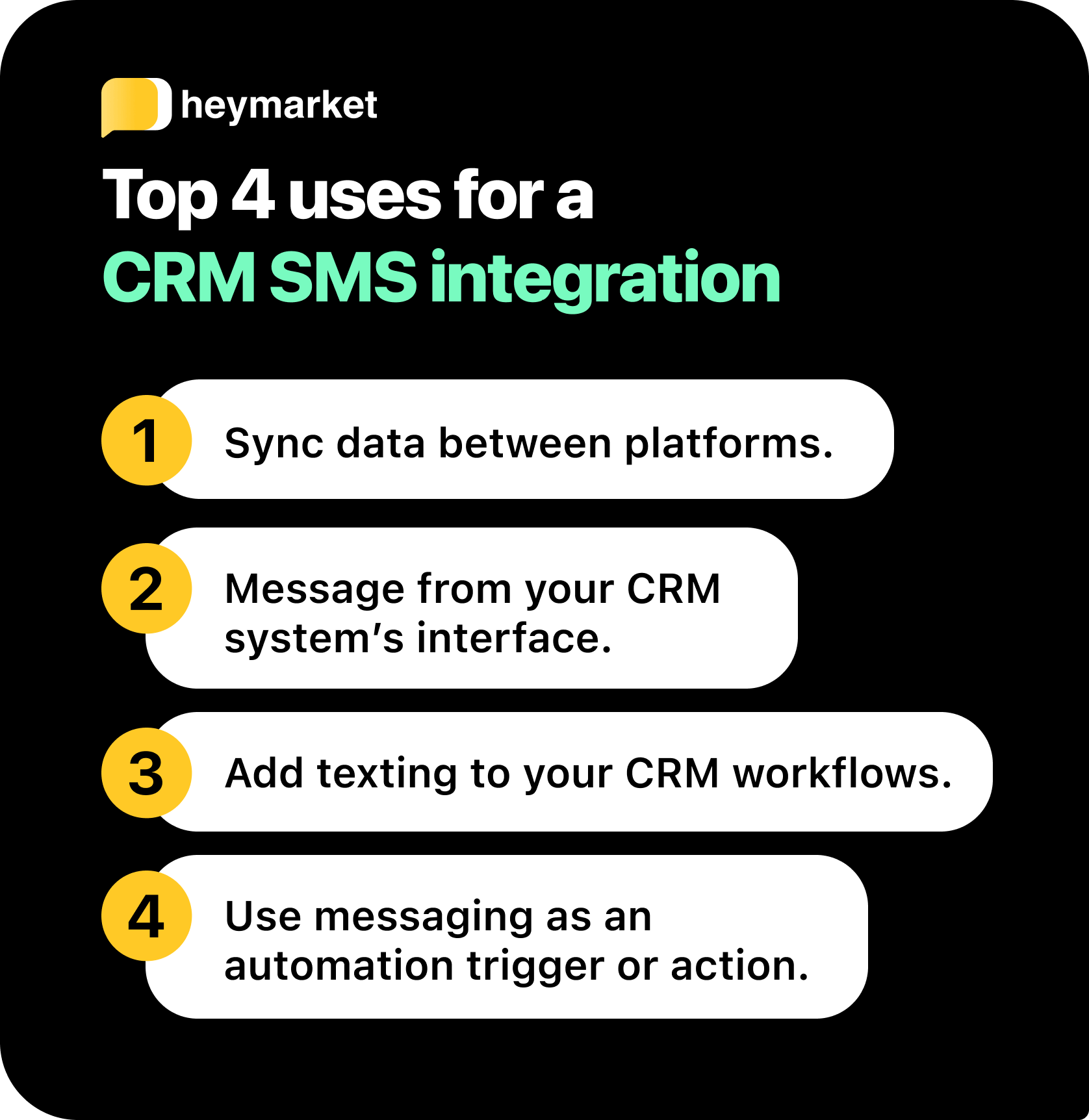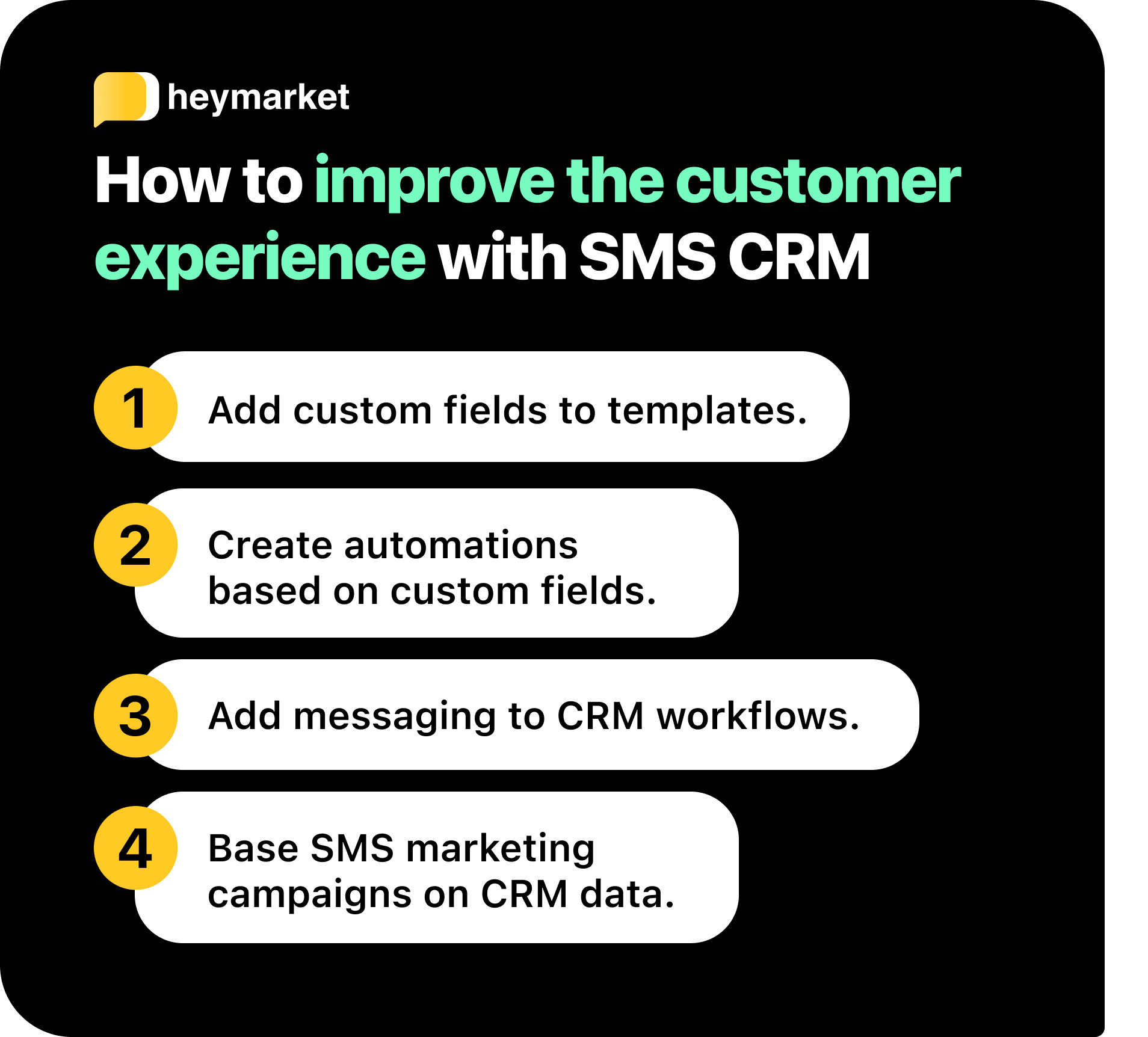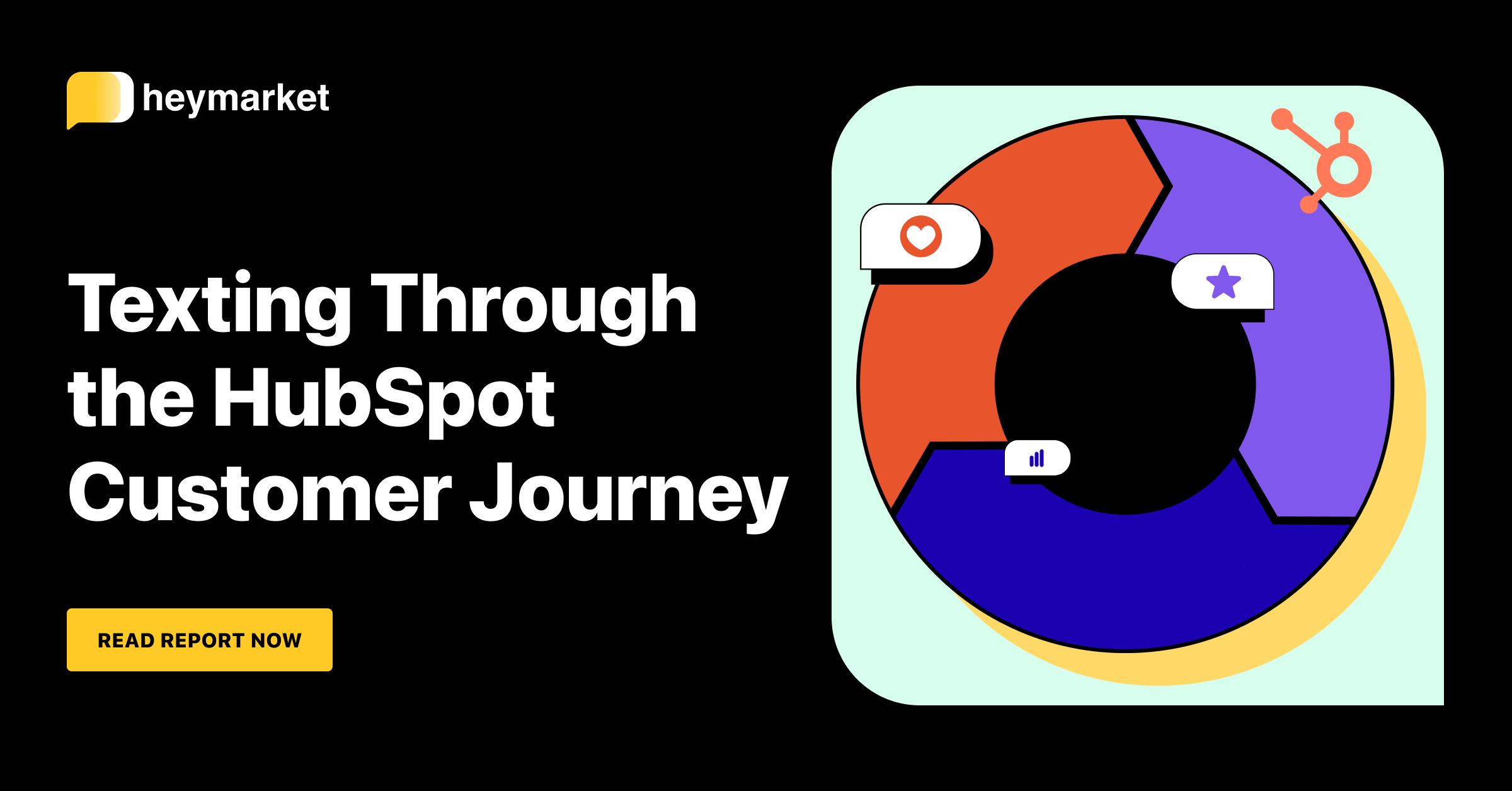
With its 98% open rate and 90-second response time, messaging is an efficient way to connect with leads and customers. Messaging helps you reach customers directly and get quick responses. A recent poll says that 97% of companies that have adopted messaging say they communicate with customers more efficiently.
But if you don’t connect texting with the business apps you use every day, you might miss out on this time savings for your team and your customers. Notably, clicking back and forth between your messaging platform and your customer relationship management (CRM) system to check data and personalize messages can slow you down. Luckily there’s an easy way to sync data between the two tools—or even text from your CRM platform directly.
An SMS CRM integration can help make the process more seamless. These SMS-CRM connections are a two-way sync between a business messaging platform and CRM software. Once they’re integrated, you can streamline workflows, personalize customer communications, and, ultimately, improve the customer experience while saving your team time.
This article will review:
- What an SMS CRM is
- What teams use it for
- Benefits of using it
- How to set up integrations with HubSpot and Salesforce
- 4 tips for using it to improving the customer experience
Let’s get started.

Want to learn more about using texting and CRM to grow customer relationships? Download our guide to texting through HubSpot.
Get the GuideWhat Is SMS CRM?
SMS CRM is an abbreviation of two terms: short messaging service (SMS), also known as text messaging, and customer relationship management (CRM). It refers to a synced messaging platform and CRM system. It’s most often used in the phrase SMS CRM integration or CRM SMS integration.

A CRM SMS integration is when your business messaging platform and CRM system are connected via their APIs. The two platforms can speak to one another, enabling them to share and sync data.
CRM SMS integrations aren’t the only SMS integrations out there. You can integrate your messaging platform with an email platform, a customer service ticketing platform, point-of-sale system, and many more cloud-based systems. As you’ll see in the following sections, these integrations offer more opportunities to get the most out of your business apps—and the most out of messaging.
What Can an SMS CRM Integration Do?
An CRM SMS integration helps your CRM system and messaging platform work together seamlessly. It lets you:
Sync data.
When you add or edit contacts and custom fields in your CRM system, they will automatically update in your messaging platform. When you add or edit contacts and custom fields in your business messaging platform, they will automatically update in your CRM. Your messaging platform can also log messages to your CRM for additional record-keeping.
Message customers right from your CRM system.
Depending on your messaging platform, you might be able to message your customers right from a tab or similar feature in your CRM system’s interface. When you click it, a shared inbox with incoming and outgoing messages will pop up, allowing you to answer and send messages.
Add messaging to your CRM workflows.
You can also add messaging to your SMS marketing workflows. For example, you can set up a text to send if an email goes unanswered for a certain amount of time or set up an email to send a certain number of days after a text.
Use messaging as a trigger or action.
You can even set up CRM SMS automations, which work across both platforms. A trigger in one platform will cause an action in the other. For example, you can set up a follow-up text to send after a custom field changes in your CRM.
How Can Teams Leverage an SMS CRM Integration?
An SMS CRM integration streamlines your team’s workflows, helping you better connect with leads and customers. Here are a few ways each team can use one:
Marketing
CRM SMS integrations help your team interest and attract leads or customers. Marketers can quickly send lists of customers product tips, updates, and event information. Your messaging platform will insert each lead’s CRM custom fields into outgoing messages. You can also set up messaging campaigns that touch base with leads on the schedule of your choice.

Click to Copy to Clipboard
Sales
Maintaining a strong customer relationship is key to closing sales. In your CRM interface, you can quickly identify and reach out to customers who need to be re-engaged with a personal note. You can also automate personalized follow-ups. When your CRM system records that a demo is over, your messaging platform can automatically send the customer a follow-up.

Click to Copy to Clipboard
Customer Service
SMS CRM integrations make it easier to engage customers. You can easily set up automations that send follow-up texts after interactions. For example, once a ticket is marked as closed in your CRM (or helpdesk system like Zendesk), your messaging platform can automatically send a survey or note.

Click to Copy to Clipboard
Copied to clipboard.
Paste anywhere you want.
Business Operations
If you manage delivery or in-field staff, you have to relay messages between those teams and customers. With an SMS CRM integration, you can receive the in-field message, open their CRM, review customer information, and relay the relevant information immediately. You can also send service or order follow-ups.

Click to Copy to Clipboard
Copied to clipboard.
Paste anywhere you want.
The Core Benefits of Integrating Your CRM and SMS
Business messaging is already a powerful tool. Text messages have an impressive 98% open rate, and customers respond to them within 90 seconds on average. Using your CRM with texting brings additional benefits:

Connected data
Your CRM system will no longer be in a silo. You can use that data to inform customer conversations and send personalized messages that increase customer engagement and satisfaction.
Streamlined workflows
An SMS CRM system allows teams to leverage existing contacts and quickly reach out to them in an automated, but personalized fashion. Streamlining outreach campaigns and follow ups helps you focus on forming strong connections with leads and customers when they respond to your messages.
Increased revenue
With help from streamlined workflows, your team will reach more people in less time, increasing efficiency and the number of new leads, prospects, and customers you connect with. Ultimately, this will lead to stronger customer relationships—and more conversions.
Connecting Your CRM and SMS
With the right messaging platform, setting up your CRM SMS integration should be fast and easy. Most platforms will natively integrate with various CRM tools such as HubSpot and Salesforce. While the process will look different depending on the messaging platform you choose, the basic steps should look something like those that follow.
HubSpot
A HubSpot SMS integration is especially powerful for those looking into marketing automation. It’s a great way to bolster your marketing campaigns with messages from your customers’ favorite channels. Setting up the HubSpot integration should look something like this:
- Choose a messaging platform that offers a HubSpot SMS integration. If you’ve already got one, proceed to the next step. Some key features to look for are:
- Your texting platform should have a 2-way sync that works with all HubSpot properties
- It should allow you to connect texting with HubSpot Conversations, Lists, and Workflows.
- It should secure your data and messages.
- Navigate to the “Integrations” tab, click on the HubSpot option, and log in to HubSpot with your HubSpot credentials. This gives both platforms permissions to share data.
- Select the HubSpot instance you want to integrate with, and click “Choose Account.” At this point, your accounts are now connected.
- Navigate to “Integration Settings” and follow the prompts (if there are any) within the HubSpot tab. These prompts will help you complete the setup by connecting your phone number, users, contacts, and custom fields (custom properties in HubSpot). If there are no more steps, the integration page will say “Manage.”
Salesforce
A Salesforce SMS integration helps you make the most of a popular CRM powerhouse. Setting up your Salesforce SMS integration should look something like this:
- Head to the Salesforce app exchange and choose a messaging platform that offers a Salesforce SMS integration. Some key features to look for are:
- Your texting platform should offer a 2-way sync that works with all Salesforce objects
- It should allow you to connect texting with Salesforce Flows, and if you use Marketing Cloud, with Journey Builder too.
- It should secure your data and messages.
- Once you’ve chosen an app, log in to your Salesforce account.
- Select “Install for Admins Only,” click “Install,” then click the box that asks for access and “Continue.” This will ensure you’ve granted permissions for the platforms to share data.
- Navigate to App Launcher and launch your texting app. Then you’ll complete final steps, such as mapping custom fields (Salesforce objects).
4 Ways to Improve the Customer Experience with an SMS CRM Integration
Once you’ve set up your integration, it’s time to start enhancing your workflows. Here are our four must-dos when you’re just getting started:

Add Custom Fields into Messages
When your business messaging platform identifies a CRM custom field in a template, it inserts the recipient’s information into it. Include custom fields in CRM SMS marketing, sales, and customer service messages to create a personalized customer experience. You might include leads’ or customers’ names, order numbers, event dates, loyalty numbers and point levels, or branch locations.

Click to Copy to Clipboard
Create Automations Based on Custom Fields
Your messaging platform can send text automations based on a custom field changing. These automations provide a seamless experience for customers. You might send a text after lifecycle stage, order, or ticket updates:

Click to Copy to Clipboard
Copied to clipboard.
Paste anywhere you want.
Enhance Current CRM Workflows
Your integration empowers you to add messages to workflows. This capability helps your team reach out to leads and customers on multiple channels, increasing engagement:

Click to Copy to Clipboard
Base Marketing Campaigns on CRM Data
You can create messaging campaigns within your CRM texting tab. Review custom fields like product interest or purchasing habits, and send a targeted message to a list of customers who follow the same trends:

Click to Copy to Clipboard
Copied to clipboard.
Paste anywhere you want.
The Bottom Line: Using Your CRM with Text Messaging
Combining your CRM with SMS messaging helps you streamline your team’s workflows and improve the customer experience. It’s a limitless tool—there will always be new cross-platform campaigns to create and enhance as your business scales or products change.
If you’re not quite ready to set up an SMS integration but would like to text from your CRM, there is another option. Your messaging platform should provide a Google Chrome extension that text-enables any web-based CRM. Click-to-text isn’t quite as extensive as a CRM SMS integration—your data won’t sync—but it’s a useful starting point.
If you move up to a CRM SMS integration and like the efficiencies you see, there’s more room to grow.
Ready for next-level CRM SMS automation tips? Learn how to use texting throughout the HubSpot Flywheel.





